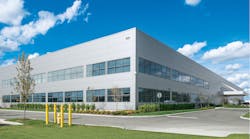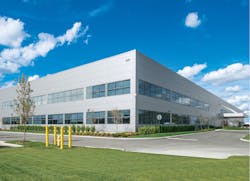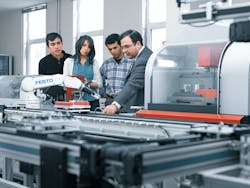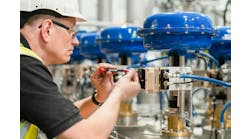Figure 1: The logistics and assembly plant in Mason is the North American brick in Festo’s global production and logistics network.
Industry 4.0, the Internet of Things (IoT), the reindustrialization of U.S. manufacturing and the skills gap in advance manufacturing all have people’s attention at the corporate, state and federal levels. "We would like to showcase how Festo can be a strong partner to support our customers and partners in the region during this fourth industrial revolution," said Yannick Schilly, head of product supply NAFTA and RCS Mason at Festo, which unveiled its newest regional service center in Mason, Ohio (Figure 1). "One is the stars of automation, including our regional service center and the standard core products that have high availability and are cost effective," he said.
The United States is now the largest export market for German mechanical engineering and machinery firms. According to a survey from the VDMA, Germany’s industrial trade group of machine builders, this trend is understood as the reindustrialization of the American economy. German machine builders delivered $18.8 billion in goods to the United States in 2015.
Figure 2: The regional service center in Mason, Ohio, has many features that are usually only found in companies selling by catalogues, such as a top-mover area, automated order picking stations and a high-performance sorting system with a daily throughput of several thousand items.
Also read: Pneumatic use is all about the fundamentals
The heart of Festo is automation with an Industry 4.0 slant. In addition to its standard part offering, Festo provides many custom parts.
It's a two-step production concept. In the first step, one of Festo’s 11 global production centers (GPCs) produces the basic product components in high quantities tailored to worldwide demand. In the second step, customized orders are transferred online to the control systems of the manufacturing departments.
When the product or component is completed at a GPC, it is transported to the regional service center (RSC) for shipment to the customer. All components in a system are grouped by barcode, packaged for shipping and then shipped out to schedule.
Festo's invested nearly $60 million in a state-of-the-art distribution and manufacturing center with a highly automated order-picking system in Mason, Ohio, which enables it to serve 70% of the North American market within a one-day truck drive (Figure 2). With the new RSC, Festo has tripled its capacity and provided space for future growth.
Figure 3: Festo Didactic’s two-year mechatronics apprenticeship program helps employers to develop the skills that are missing by combining theoretical education, hands-on training and on-the-job training.
With a storage capacity of 65,000 bins, the highly automated warehouse system, implemented by Witron, a designer and supplier of fully automated warehouse and logistics systems, features seven high-performance picking stations and the capability to pick and pack 1,000 items per hour. “As regional and U.S. sales continue to grow, this regional service center will provide a strong product supply backbone for the North American market with best in class supply chain performance," said Schilly.
Festo is committed to training and education with its ultimate goal of increasing the productivity of its customers around the world, said Tony Oran, head of direct sales, Festo Didactic. "Industry 4.0 and the IoT is changing industry which also means we are going to have to change our education system. Interaction with intelligent machines requires new abilities to be able to interact with those machines. Increased complexity requires different problem-solving skills. It all requires a high degree of self-directed action and communication, the ability to self-organize and life-long learning."
Festo Didactic’s apprenticeship program helps employers to fill the skills gap in advanced manufacturing (Figure 3). The program uses the German apprenticeship model of dual education, where apprentices learn in a classroom and maintain a steady job. Every week each apprentice spends one day at SinclairCommunity College for classes, one day using state-of-the-art equipment at the new FestoLearningCenter in Mason and three days working at their respective employers. The apprentices are able to take what they learn in class, practice it at the FestoLearningCenter and then use that new knowledge and skill in a real-life work environment.
The two-year mechatronics apprenticeship is designed to help individuals learn advanced manufacturing skills, as well as earn an associate’s degree in mechatronics. The first cohort of the program includes 11 apprentices who are training for careers as maintenance technicians, automation specialists, service technicians and manufacturing technicians.
Sidebar images courtesy of Festo










